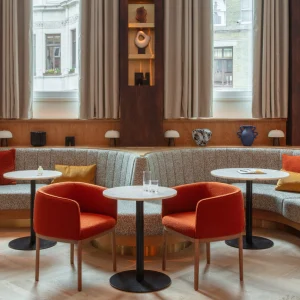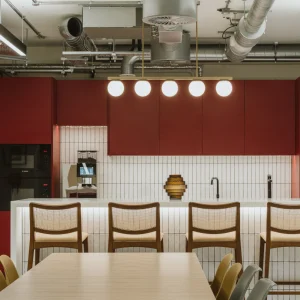60 – Austin-Smith:Lord
This architecture and design practice celebrates 60 glorious years. Beginning with its two founders, Mike and Inette Austin-Smith, the firm today has nearly 200 staff and has worked on more than 2,500 projects.
What have been your highlights?
Mike and Inette wrote RIBA’s original plan of work [the process of managing and designing building projects]. That was a first, an early highlight. The next big step was the expansion outside London. Our first office out of the capital was in Warrington, where we were responsible for the New Town project. Today, we have five locations in the UK and one in Abu Dhabi. We also won 2010’s practice of the year at the Architects Journal’s AJ100 Awards.
What’s changed most?
Sixty years ago the role of the architect was that of project leadership. Now we are service providers in a supply chain, along with a number of other disciplines. We are sometimes wholly managed by people or organizations which are not the ultimate client.
What are your plans/hopes for the rest of 2011?
Instead of being organised around geographical locations, this year we refocused ourselves around different disciplines. For instance, I am leading the RENEW discipline. This is concerned with more than just pure conservation, including fit-out, retrofitting and reusing existing buildings. The other sectors to which we’ve committed significant investment are industry and infrastructure, transportation, arts and culture and urban regeneration.
What’s there to celebrate in the architecture and design sector?
We’ve just got to be positive. It is harder, but we have to enjoy the work we have. The rest of the year is still going to be a challenge. We have to find ways to produce work for lower fees, and out of that will come innovative ways of running a practice.
50 – BDP
Fifty years have passed since George Grenfell Baines founded BDP in Preston. To celebrate, BDP has held an exhibition at RIBA and produced a commemorative book and film (entitled 5 Cities, 5 Places, One Day) of its now international, interdisciplinary practice. Projects range from Glasgow Science Centre to Queen Elizabeth Hospital in Birmingham to the Liverpool One retail complex.
What have been your highlights?
What gives us huge pride is the retention and refinement of our founding ethos, values and community. We have changed hugely, but our DNA remains strong and would be distinctly recognisable. We’ve designed many quality projects over the years and have won 73 RIBA awards, including two in 2011.
What’s changed most?
Technology, speed and international reputation. Also, the new way of design put forward by George Grenfell Baines was then thought to be rebellious, but we simply got on with the practice of interdisciplinary design.
What are your plans/hopes for the rest of 2011?
BDP is well positioned to grab new opportunities, while extending our reputation, portfolio and service to markets further afield in India, Middle East, China and North America.
What is there to celebrate in the architecture and design sector in 2011?
Western economies will recover and their ability to continue to provide the required social and commercial infrastructure will re-emerge. Also, British design and engineering is among the best in the world; while the UK may be having a ‘fallow’ period, our industry is succeeding abroad.
50 – Bisley
Bisley’s filing cabinets are an essential part of the modern office. From its manufacturing base in Newport, south Wales, Bisley has operated for 50 years, continuing to reinvent the art of storage with products such as the Bite system.
What have been your highlights?
I’ve always been a manufacturing man at heart and believe in investing in the latest and best technology to help raise productivity and maintain or improve quality. We have spent some £3.25m on this in 2011, which is also important to keep our competitive edge.
What’s changed most?
Our direct involvement in the designers and specifiers started in around 1995 and we have greatly enjoyed the challenge of developing higher-end products to suit this sector. Engineering is the natural partner of design, and working closely in this way can be an enriching experience for both parties.
What are your plans/hopes for the rest of 2011?
The marketplace in which we operate has changed dramatically and the UK manufactures far less, facing enormous competition from places such as China and India. I hope that we can continue to manufacture furniture in the UK and remain competitive in world markets. Exports sales have grown by 20 per cent in the past year and they now represent more than 40 per cent of our total sales.
What is there to celebrate in the A & D sector in 2011?
A business is often judged by the company it keeps and we’ve been involved with a good number of high-profile projects.
We have been especially pleased with our involvement with the BBC Salford Quays project and a very large installation for BNP Paribas in Paris.
30 – MMoser
MMoser Associates this year celebrates 30 years of creating workplace environments, corporate base buildings and campuses, now with more than 600 staff in 11 offices worldwide.
What have been your highlights?
Bringing a new and radical results-driven approach to interior architectural projects. That so many of our global clients have entrusted us with projects of significant scale and profile is extremely humbling. I’d pick out our recent 11,000 sq m HQ project for Halcrow, the redesign of Ernst & Young’s flagship More London reception and our recent 6,600 sq m success for a financial media client at Park House in Finsbury Circus.
What’s changed most?
Clients now need their design companies to add value to their businesses in tangible and measurable ways. Properly understanding our clients’ businesses and being able to deliver the result is critical to their business success. Also, the old communication patterns of architectural documentation are becoming less effective as the speed of delivery and collaboration increases.
What are your plans/hopes for the rest of 2011?
We continue to develop new capabilities in step with the needs of corporate clients. One example is ‘inside-out’ architecture: a method of designing whole buildings around operational goals and requirements so that they support the users’ activities. We’re also building momentum in the area of specialised, engineering-intensive work facilities such as labs, data centres and trading floors.
What is there to celebrate in the A & D sector in 2011?
Much! Clients are seeking more innovative and accountable project teams. Our 30 years’ experience in delivering excellence in highly challenging markets means we havea real story they want to hear.
40 – Hitch Mylius – 40th anniversary
In deepest Enfield a small team of highly skilled fabric cutters are checking over the fabric for flaws, marking out the pattern in the best way to minimise off-cuts, and carefully cutting the shapes that will be stitched up ready for upholstering elsewhere in the small factory.
This close attention to crafting upholstered furniture has helped Hitch Mylius survive and thrive for 40 years in the increasingly competitive contract design market. Turnover is at its highest ever and the company recently delivered two huge orders without disrupting its regular production – 1,100 of Simon Pengelly’s hm86 chairs for a hotel in Amsterdam and hundreds of sofas for the world’s largest women-only university, the Princess Noura University in Riyadh.
It’s a far cry from the company’s beginnings, when Tristram Mylius and John Hitch started designing and making upholstered furniture in Mylius’s double garage in Essex, armed with a hand-sewing machine and a bread knife.
“We were literally doing everything by ourselves,” says Mylius, who still has his own workbench and tools in the prototyping room at Hitch Mylius, and a hands-on approach.
Mylius had previously worked as design assistant to architect Theo Crosby in the multidisciplinary practice Crosby Fletcher Forbes, which eventually became Pentagram. He has run Hitch Mylius with wife Hazel since 1980 when Hitch left, and has been the energetic driving force behind the company’s evolution. There have been some significant changes, in particular the company’s shift from domestic market to concentrate on contract furniture. This has become a more crowded arena. “As a small design-led company our challenge is to stay at the forefront with product and design developments,” says Mylius.
One way to do this has been to commission external designers, which Mylius started doing in the Eighties to supplement his own designs. This has led to a long line of often highly fruitful collaborations with notable designers including Simon Pengelly, Nigel Coates and Kenneth Grange. Pengelly’s hm86 chair is Mylius’s all-time favourite – and best-selling – HM product. As well as being comfortable it is, says Mylius, ‘quiet, simple and beautiful – what this company is all about’.
Mylius relishes these creative partnerships and is particularly excited about the healthcare market – a new venture for Hitch Mylius. There’s no chance he’ll let Hitch Mylius rest on its laurels. Instead, he is looking forward to further growth, particularly in exports to mainland Europe. And above all, there are plenty of new collaborations with designers in the pipeline including products by Pengelly and Belgian-based designer Stefan Schoning.
‘We’ll continue to innovate on new designs,’ says Mylius. ‘Without new products, what reason do we have to talk to people?’ Pamela Buxton
21 – Nightingale Associates
Nightingale Associates celebrates 21 years in practice and its specialism in healthcare, science and education. Projects include Hove Polyclinic, completed in 1997, the Clinical Education Centre at Keele University and the Oxford Molecular Pathology Institute, completed in 2010.
What have been your highlights?
We have grown from a small practice to a peak of 300 employees in six design studios in the UK and one in Cape Town. We are proud to have built up to a design firm, specialising in health, education and science-based projects.
What’s changed most?
There has been a significant shift from traditional owner/occupier clients to being employed by developer consortia or main contractors. Plus, there is now a strong emphasis on design quality and innovation. This is underpinned by the work of [the firm’s research arm] Nightingale THiNK.
What are your plans/hopes for the rest of 2011?
Our next key objective is to expand our services worldwide. This has been dramatically moved forward by our joining the IBI Group in 2010. We are in the process of planning and implementing the delivery of our design specialisms throughout the IBI Group’s 90 offices worldwide. We are particularly excited by the prospect of expanding our interior design services by linking up and exploiting our rich joint experiences.
What is there to celebrate in the A & D sector in 2011?
It is wonderful to see the continuing success and high regard that UK-based architects and designers have earned abroad. This is exemplified by the numbers of high-profile commissions that are being won in expanding markets such as Canada, Malaysia, China and India.
21 – Kinnersley Kent Design
Kinnersley Kent Design has, at 21 years old, the key to the designer door. Its projects have varied from designing an automotive showroom for Mercedes-Benz to creating a new retail concept for Jaeger London to most recently working on a department store onboard P&O Ferries’ new ships, the Spirit of Britain and the Spirit of France.
What have been your highlights?
I first met Mick [Kent] at university. We were both studying for our MAs at Central School of Art & Design in London. Mick’s MA was in product design, mine in industrial design. Ironically we both found salvation in retail design! The rest, as they say, is history. Opening our office in Dubai in 2009 was a highlight. There we can better serve our existing clients on the ground and expand our creative hub beyond Dubai to the wider Middle Eastern region. Another highlight was promoting Paul McElroy to become our third partner in the business in 2005.
What’s changed most?
Over the past 20 years design companies with the ability to adapt and innovate have survived and thrived in this ever-changing industry. It is exciting to be a part of the evolution. The most obvious is that the internet changed everything. Before the internet came along, purchasing decisions and the way we shopped were simple. You now no longer need to visit a bricks-and-mortar store in order to make a purchase, though there is still a big place for bricks-and-mortar stores in the world. For Jaeger London, for example, it’s all about the shopper experience, service and convenience.
What are your plans/hopes for the rest of 2011?
We are building our own brand from the inside out. We’re investing in our people, resources, processes and systems to ensure we remain at the cutting edge of our industry. We’re also refurbishing all of our brand touch points: from our office and studio environments to our website and tone of voice. Innovation is very much in Kinnersley Kent’s thinking. Going forward, we will always aim to remain a medium-sized design business, small enough to retain our boutique culture as this is what is most important to our clients, but big enough to be profitable.
What is there to celebrate in the A & D sector in 2011?
Worldwide, the retail industry is emerging from a difficult time. Although opportunities have decreased with a more cautious stance by clients, they aren’t nonexistent. Specific opportunities do exist for retail and leisure design. For example, our London studio is working on some exciting projects that include new concepts for House of Fraser, the Tower of London and American Express. Good ideas, well implemented, can overcome most challenges we face. Kinnersley Kent Design has always been, and will always be, a passionate ambassador for great British Design.
21 – Colebrook Bosson Saunders
Colebrook Bosson Saunders draws on Martyn Colebrook’s skills in architecture, Peter Bosson’s product design experience and Brenda Saunders’ knowledge of furniture design. Its expertise lies in adjustable workspace solutions such as monitor supports, CPU cradles and laptop supports.
What have been your highlights?
(MyC) ‘A big milestone was in 1999 when we made our first flat-screen arm. Flat screens freed up so much desk space. That’s when we started doing loads of work with trading floors.’
What’s changed most?
(MyC) The emphasis on health and safety at work drove the demand for ergonomics in the workplace. We have grown internationally too. Sixty per cent of our business is overseas. (MiC) Audio visual facilities and video conferencing have also had an impact. (AW) It’s also about the generation coming into the workforce, used to touchscreens and social networking. Office workers are going to embrace new technology more, plus there’s shift towards cloud-based networking, meaning organisations won’t need as much room for hard drives.
What are your plans/hopes for the rest of 2011?
(MiC) The key thing is new locations and new products. We are recruiting more international sales people and we are taking staff on in China.
What is there to celebrate in the A & D sector in 2011?
(MiC) The heart of what we do is actually working with the architecture and design community, which is something to celebrate. It’s not just about selling our product designs, it’s about solutions. (AW) We have our design studio and prototyping centre here at our headquarters at London Bridge. That way, we can respond to the marketplace incredibly quickly.





